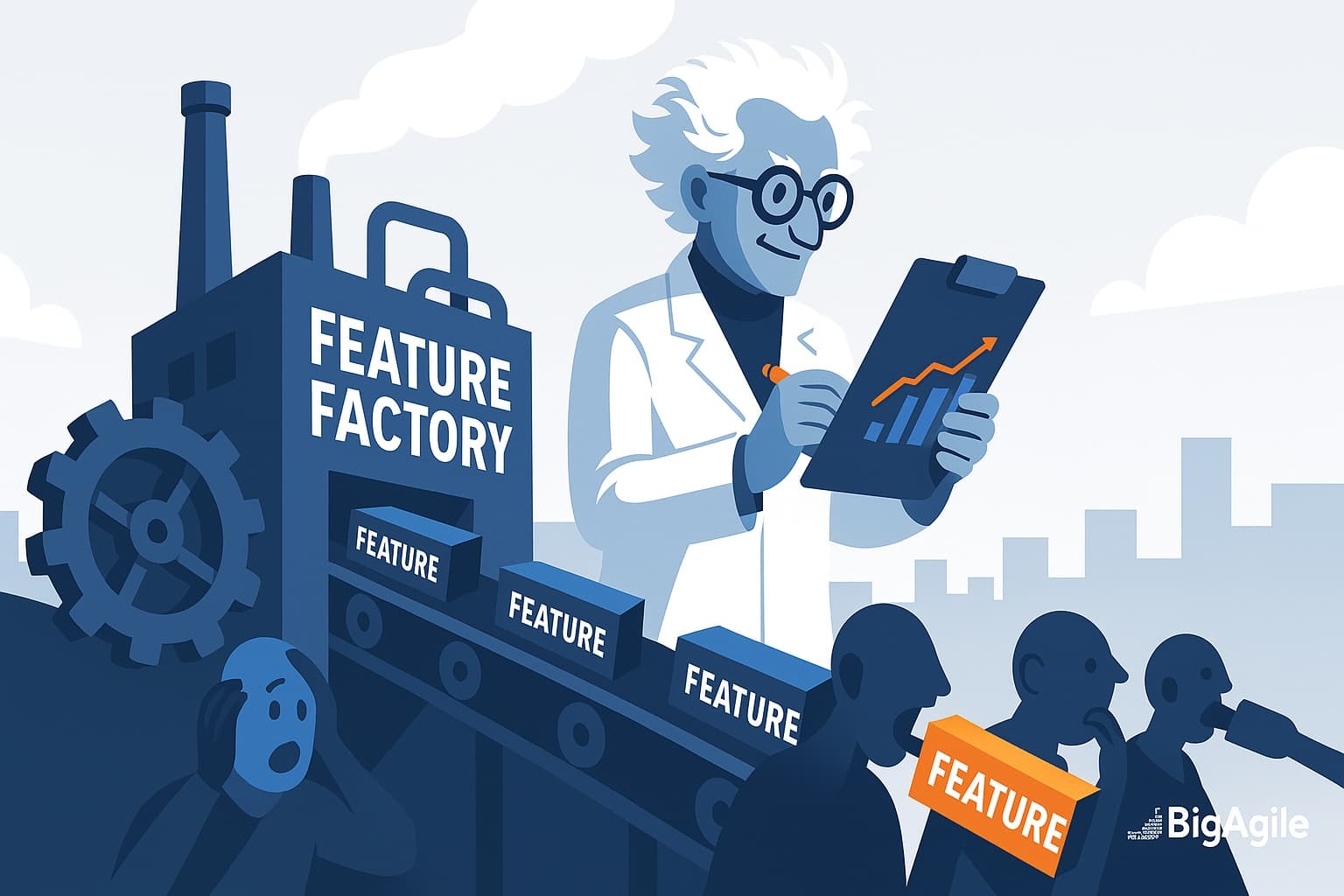
In today’s fast-paced tech landscape, it’s easy to fall into the trap of churning out feature after feature. The modern product development mantra often seems to be, “Ship fast, ship often.” Heck, I even teach organizations how to set themselves up to deliver that way, LOL.
This approach can lead companies into a feature factory mindset, focusing on outputs instead of outcomes. I’ve seen it repeatedly and must admit that I am sometimes complicit.
It’s time to evolve. The conversation is shifting from simply building more features to ensuring that every development decision addresses user pain points and delivers measurable value. That’s the point of agile anyway; we’ve lost sight of that and swung the pendulum too hard into optimizing delivery (maybe that is okay).
I wanted to take some time this week to explore the pitfalls of an output-centric mindset, explain why user stories aren’t enough and offer actionable strategies—like leveraging OKRs and continuous discovery loops—to ensure that companies validate products effectively and deliver measurable outcomes.
The Problem with the Feature Factory Mindset
A common misconception in product development is that a well-crafted user story guarantees a successful outcome (We probably don’t really believe that, but we sure act like it sometimes).
While a user story helps teams capture a user task in context, it doesn’t necessarily positively impact the user’s life or business performance. The focus on simply closing off user stories can lead to a deluge of features that look good on paper but fail to address users’ core problems.
Instead of asking, “Did we complete the user story?” ask, “Did this feature make a meaningful change in how our users work, feel, or succeed?”
Many companies don’t realize they’ve slipped into a feature factory until it’s too late. Here are a few telltale signs:
- High output, low impact: Your team celebrates a record number of feature releases, yet user engagement and satisfaction remain stagnant.
- Redundant features: Multiple products or updates solve the same problem with minor variations, leaving critical pain points unaddressed.
- Over-reliance on vanity metrics: Metrics like “features shipped” or “code commits” look impressive but don’t capture the real value delivered to customers.
If these symptoms resonate, reframing your product development approach is time.
Leverage OKRs (Objectives and Key Results)
OKRs shift the focus from what you’re building to why you’re creating it. Rather than lining up a list of features to deploy, your objectives should articulate users’ real problems—reducing friction in the customer journey or improving overall satisfaction. Your key results become measurable impacts, such as increased conversion rates, reduced churn, or higher user retention.
- Define clear, outcome-driven OKRs that link directly to user pain points.
- Regularly review progress and pivot if the key results aren’t moving in the desired direction.
Embrace Continuous Discovery Loops
Product validation shouldn’t end at launch. Integrating continuous discovery loops into your workflow means regularly checking in with your users, getting feedback, and observing how they interact with your product. This approach ensures that you’re always solving real problems rather than assuming a feature works perfectly simply because it’s been shipped.
Example Practices:
- Schedule frequent user interviews, surveys, and usability studies.
- Set up mechanisms to gather and analyze real-time usage data.
- Iterate quickly based on findings—refining or even pivoting when the data indicates it’s necessary.
Real Examples of Vanity Delivery Metrics
Vanity metrics often provide a false sense of security. For instance, a spike in feature releases might be celebrated within the organization, but the celebration is misplaced if users aren’t engaging with or benefiting from these new functionalities. Real success can only be measured by tracking metrics that matter:
- User satisfaction scores: Are users happier than before?
- Time-to-value: Has the feature reduced users’ time to achieve a goal?
- Retention rates: Are customers sticking around longer after the feature rollout?
Switching to these metrics forces teams to consider the value and impact of each feature rather than its mere existence.
Develop a Culture of Problem-Solving
Start by instilling a mindset that prioritizes problem-solving over feature production. This culture shift can be achieved by:
- Highlighting user outcomes in team meetings: Celebrate stories and data that reflect how users benefit, not just how many features were added.
- Training and development: Invest in workshops focusing on user empathy, effective user research techniques, and outcome-driven innovation.
Encourage Cross-Functional Collaboration
Collaboration between product managers, designers, engineers, and even marketing is critical in today’s complex product ecosystems. Cross-functional teams can collectively focus on validating features against user needs and ensure the product evolves toward solving core problems.
- Set up regular team syncs to share insights from user data and research.
- Use collaborative tools to maintain transparent OKRs and track outcomes across departments.
Integrate Advanced Analytics and Feedback Tools
Use analytics tools to monitor real-world usage and build dashboards that track key outcome metrics. Combining quantitative data with qualitative feedback creates a holistic view of user impact. This data-driven approach will highlight which features truly solve user problems and which are just adding noise.
Let's End It!
As companies grow and scale, the pressure to ship more features can overshadow the ultimate goal: creating value for users.
By embracing an outcome-focused approach, leveraging OKRs (or whatever you choose), embedding continuous discovery loops, and validating products effectively, organizations can ensure that every feature they ship is a step toward solving their users’ real problems.
Stop shipping features for the sake of shipping features and start solving problems. This isn’t just a change in tactics—it’s a fundamental shift in how we approach product development in an increasingly competitive digital landscape. By prioritizing outcomes over outputs, we can drive better business metrics and create products that genuinely resonate with and empower their users.
Embrace the change, and let the journey toward proactive product validation drive your organization to new heights of innovation and user satisfaction.